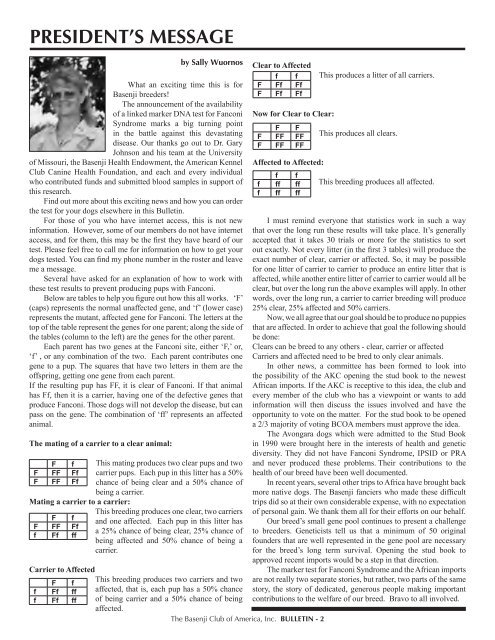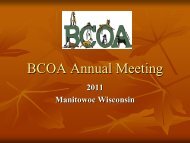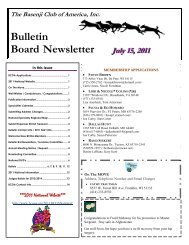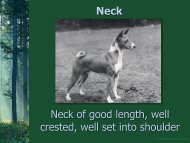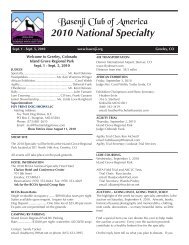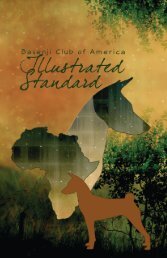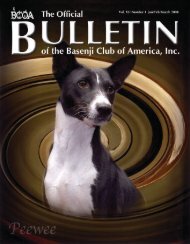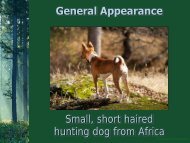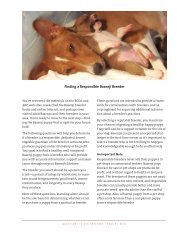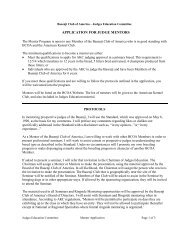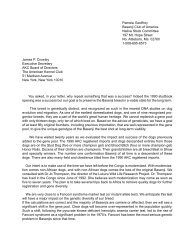BCOA Bulletin January-February-March 2007 - the Basenji Club of ...
BCOA Bulletin January-February-March 2007 - the Basenji Club of ...
BCOA Bulletin January-February-March 2007 - the Basenji Club of ...
Create successful ePaper yourself
Turn your PDF publications into a flip-book with our unique Google optimized e-Paper software.
PRESIDENT’S MESSAGE<br />
What an exciting time this is for<br />
<strong>Basenji</strong> breeders!<br />
The announcement <strong>of</strong> <strong>the</strong> availability<br />
<strong>of</strong> a linked marker DNA test for Fanconi<br />
Syndrome marks a big turning point<br />
in <strong>the</strong> battle against this devastating<br />
disease. Our thanks go out to Dr. Gary<br />
Johnson and his team at <strong>the</strong> University<br />
<strong>of</strong> Missouri, <strong>the</strong> <strong>Basenji</strong> Health Endowment, <strong>the</strong> American Kennel<br />
<strong>Club</strong> Canine Health Foundation, and each and every individual<br />
who contributed funds and submitted blood samples in support <strong>of</strong><br />
this research.<br />
Find out more about this exciting news and how you can order<br />
<strong>the</strong> test for your dogs elsewhere in this <strong>Bulletin</strong>.<br />
For those <strong>of</strong> you who have internet access, this is not new<br />
information. However, some <strong>of</strong> our members do not have internet<br />
access, and for <strong>the</strong>m, this may be <strong>the</strong> first <strong>the</strong>y have heard <strong>of</strong> our<br />
test. Please feel free to call me for information on how to get your<br />
dogs tested. You can find my phone number in <strong>the</strong> roster and leave<br />
me a message.<br />
Several have asked for an explanation <strong>of</strong> how to work with<br />
<strong>the</strong>se test results to prevent producing pups with Fanconi.<br />
Below are tables to help you figure out how this all works. ‘F’<br />
(caps) represents <strong>the</strong> normal unaffected gene, and ‘f’ (lower case)<br />
represents <strong>the</strong> mutant, affected gene for Fanconi. The letters at <strong>the</strong><br />
top <strong>of</strong> <strong>the</strong> table represent <strong>the</strong> genes for one parent; along <strong>the</strong> side <strong>of</strong><br />
<strong>the</strong> tables (column to <strong>the</strong> left) are <strong>the</strong> genes for <strong>the</strong> o<strong>the</strong>r parent.<br />
Each parent has two genes at <strong>the</strong> Fanconi site, ei<strong>the</strong>r ‘F,’ or,<br />
‘f’ , or any combination <strong>of</strong> <strong>the</strong> two. Each parent contributes one<br />
gene to a pup. The squares that have two letters in <strong>the</strong>m are <strong>the</strong><br />
<strong>of</strong>fspring, getting one gene from each parent.<br />
If <strong>the</strong> resulting pup has FF, it is clear <strong>of</strong> Fanconi. If that animal<br />
has Ff, <strong>the</strong>n it is a carrier, having one <strong>of</strong> <strong>the</strong> defective genes that<br />
produce Fanconi. Those dogs will not develop <strong>the</strong> disease, but can<br />
pass on <strong>the</strong> gene. The combination <strong>of</strong> ‘ff’ represents an affected<br />
animal.<br />
The mating <strong>of</strong> a carrier to a clear animal:<br />
F f<br />
F FF Ff<br />
F FF Ff<br />
Mating a carrier to a carrier:<br />
F f<br />
F FF Ff<br />
f Ff ff<br />
Carrier to Affected<br />
F f<br />
f Ff ff<br />
f Ff ff<br />
by Sally Wuornos<br />
This mating produces two clear pups and two<br />
carrier pups. Each pup in this litter has a 50%<br />
chance <strong>of</strong> being clear and a 50% chance <strong>of</strong><br />
being a carrier.<br />
This breeding produces one clear, two carriers<br />
and one affected. Each pup in this litter has<br />
a 25% chance <strong>of</strong> being clear, 25% chance <strong>of</strong><br />
being affected and 50% chance <strong>of</strong> being a<br />
carrier.<br />
This breeding produces two carriers and two<br />
affected, that is, each pup has a 50% chance<br />
<strong>of</strong> being carrier and a 50% chance <strong>of</strong> being<br />
affected.<br />
Clear to Affected<br />
f f<br />
F Ff Ff<br />
F Ff Ff<br />
Now for Clear to Clear:<br />
F F<br />
F FF FF<br />
F FF FF<br />
Affected to Affected:<br />
f f<br />
f ff ff<br />
f ff ff<br />
The <strong>Basenji</strong> <strong>Club</strong> <strong>of</strong> America, Inc. BULLETIN - 2<br />
This produces a litter <strong>of</strong> all carriers.<br />
This produces all clears.<br />
This breeding produces all affected.<br />
I must remind everyone that statistics work in such a way<br />
that over <strong>the</strong> long run <strong>the</strong>se results will take place. It’s generally<br />
accepted that it takes 30 trials or more for <strong>the</strong> statistics to sort<br />
out exactly. Not every litter (in <strong>the</strong> first 3 tables) will produce <strong>the</strong><br />
exact number <strong>of</strong> clear, carrier or affected. So, it may be possible<br />
for one litter <strong>of</strong> carrier to carrier to produce an entire litter that is<br />
affected, while ano<strong>the</strong>r entire litter <strong>of</strong> carrier to carrier would all be<br />
clear, but over <strong>the</strong> long run <strong>the</strong> above examples will apply. In o<strong>the</strong>r<br />
words, over <strong>the</strong> long run, a carrier to carrier breeding will produce<br />
25% clear, 25% affected and 50% carriers.<br />
Now, we all agree that our goal should be to produce no puppies<br />
that are affected. In order to achieve that goal <strong>the</strong> following should<br />
be done:<br />
Clears can be breed to any o<strong>the</strong>rs - clear, carrier or affected<br />
Carriers and affected need to be bred to only clear animals.<br />
In o<strong>the</strong>r news, a committee has been formed to look into<br />
<strong>the</strong> possibility <strong>of</strong> <strong>the</strong> AKC opening <strong>the</strong> stud book to <strong>the</strong> newest<br />
African imports. If <strong>the</strong> AKC is receptive to this idea, <strong>the</strong> club and<br />
every member <strong>of</strong> <strong>the</strong> club who has a viewpoint or wants to add<br />
information will <strong>the</strong>n discuss <strong>the</strong> issues involved and have <strong>the</strong><br />
opportunity to vote on <strong>the</strong> matter. For <strong>the</strong> stud book to be opened<br />
a 2/3 majority <strong>of</strong> voting <strong>BCOA</strong> members must approve <strong>the</strong> idea.<br />
The Avongara dogs which were admitted to <strong>the</strong> Stud Book<br />
in 1990 were brought here in <strong>the</strong> interests <strong>of</strong> health and genetic<br />
diversity. They did not have Fanconi Syndrome, IPSID or PRA<br />
and never produced <strong>the</strong>se problems. Their contributions to <strong>the</strong><br />
health <strong>of</strong> our breed have been well documented.<br />
In recent years, several o<strong>the</strong>r trips to Africa have brought back<br />
more native dogs. The <strong>Basenji</strong> fanciers who made <strong>the</strong>se difficult<br />
trips did so at <strong>the</strong>ir own considerable expense, with no expectation<br />
<strong>of</strong> personal gain. We thank <strong>the</strong>m all for <strong>the</strong>ir efforts on our behalf.<br />
Our breed’s small gene pool continues to present a challenge<br />
to breeders. Geneticists tell us that a minimum <strong>of</strong> 50 original<br />
founders that are well represented in <strong>the</strong> gene pool are necessary<br />
for <strong>the</strong> breed’s long term survival. Opening <strong>the</strong> stud book to<br />
approved recent imports would be a step in that direction.<br />
The marker test for Fanconi Syndrome and <strong>the</strong> African imports<br />
are not really two separate stories, but ra<strong>the</strong>r, two parts <strong>of</strong> <strong>the</strong> same<br />
story, <strong>the</strong> story <strong>of</strong> dedicated, generous people making important<br />
contributions to <strong>the</strong> welfare <strong>of</strong> our breed. Bravo to all involved.


